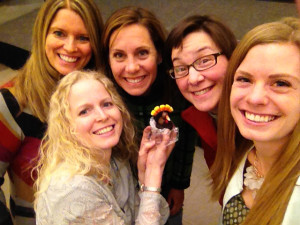
Thankful for my children’s critique friends: Lou Aamodt, Kristi Herro, Alicia Scwab, Elise Parsley. (See who else I’m thankful for on MY WRITING FRIENDS page.)
Recently, my wise writer/illustrator friend, Elise, marveled that we’re learning so much while reading, researching, writing, and reviewing with our writers groups; it’s like receiving a free graduate degree in children’s literature.
Her reflection sparked this meet-up mindset for me: This is more than friend-time. I’m part of a graduate program, learning from some of the best and the brightest. Don’t take one minute of this for granted.

2014-2015 SCBWI Writer Mentor Trisha Speed Shaskan has written over 40 books, including HONESTLY, LITTLE RED RIDING HOOD WAS ROTTEN!; TRULY, WE BOTH LOVED BEAUTY DEARLY!; and her 2015 release, PUNK SKUNKS, co-created with her husband, Stephen Shaskan. I’m beyond grateful for this opportunity to learn from her and get to know her as a friend and fellow lover of children’s literature.
After friendship, the best part about writers groups is the knowledge we share. For me, it’s definitely a win-win, because my comrades are all smarter than me. We’re like one big, spongy, interconnected brain. So, of course I had my writing friends in mind when I was selected this October by the MN Society of Children’s Book Writers & Illustrators (SCBWI) Conference Committee for the 2014-2015 Writer Mentorship with children’s book author, Trisha Speed Shaskan. Woo hoo! I would finally have something juicy and substantial to bring to the table!
I’m honored that Ms. Speed Shaskan (Trisha) and the committee found promise in my work and are devoted to prodding me past mediocrity. To pay this kindness forward, I’ve asked Trisha if I could share her wisdom, not only with my writers group friends, but with anyone who visits this blog. She generously said “yes,” so, rather than recapping from memory, I’ll share the email I sent to my critique friends.
To: Critique Lovelies
Subject: Mentorship notes
Hello!
I met with Trisha last evening and came away with a treasure chest full of wisdom.
I inquired about diverse reactions we’ve received from reviewers pertaining to alliteration in picture books. (Who’s right, those for and against?) Trisha laughed, because she wrote a book called, IF YOU WERE ALLITERATION. For picture books, she loves it.
Concerning word choices in children’s books, she thought words like “clambered” and “musty” were perfectly acceptable—even more desirable than dumbed down words. She said to think of picture books like a poem or a song and to go with the rhythm and words that ring true to the story. Since picture books are usually read by adults to children, (unlike easy readers and early chapter books, where the words need to be carefully selected for young readers) she said, “By all means, go for elevated, beautiful, active language.”
And she loves onomatopoeia. In fact, in my story she suggested I add more onomatopoeia, such as a “shuffled” during the stampede scene.
Concerning critique format, the following is the one her group incorporated. They’ve tried others and like this best:
Summary:
What Works:
Questions:
—Character
—Setting/World Building
—Physical Description
—RefrainFinal Note:
The process is similar to ours, but more formal.
The “summary” helps determine whether the writer’s vision has been successfully communicated. A bonus: it’s a helpful tool later, when creating a pitch.
“What works” helps the writer determine what to keep.
“Questions” make the story stronger. For instance, Trisha asked some of the same questions you asked. That showed me what I need to clarify.
She said it’s important to know the rules of the world we’re creating and stay consistent.
And sometimes to be generous and just tell the reader information directly, rather than trying to be subtle.
To reduce words, she gave me two examples where I used repetitive emotions (that the illustrator will certainly reinforce) and said that eliminating one in each phrase would be an effective way to condense:
- Shuddering, she slumped over her tomatoes and stroked the empty peddler space on her sash.
- The Grand Duchess stomped toward the tower. (One word can replace four.) “I’LL TOSS HER TO THE CROCODILES MYSELF!”
Her critique for my manuscript was a page and a half, single-spaced. She suggested starting with the above format, then she will follow-up with line-by-line reviews after the questions have been addressed.
I hope I’ve shared something that will help you as well.
Much thanks to Trisha for her thoughtfulness and generosity! Watch for more Speed Shaskan wisdom in future posts.
